OPERATION MERKUR
The German Invasion of Crete
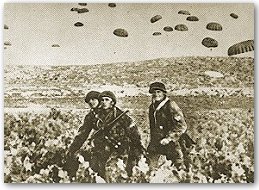
"The German Army has been ordered to take
the island. It will carry out this order"
Possession of Crete was of great strategic importance. For the British
it was to maintain naval supremacy in the eastern Mediterranean. Suda provided
the Mediterranean Fleet with a forward base 420 miles forward of Alexandria.
For the Germans, the island of Crete would provide an ideal forward
base in which to conduct offensive air and naval operations and to support
the ground offensive in Egypt. It's capture would also deny Allied
aircraft potential bases for striking at Germany's Ploesti oil fields in
Romania.
 |
| Enter Map Room |
|
The staff of Luftflotte 4 - which had been committed to the Balkans
under command of Alexander Löhr, conceived the idea of capturing the
island and forwarded the plan to Göering at the time of the invasion
of Greece. He thought highly of it but the Oberkommando der Wehrmacht would
have preferred action against Malta.
On the April 20, after a conference with Generalleutenant Kurt
Student (Commander XI. Fliegerkorps), Hitler decided in favour of invading
Crete rather than Malta; and five days later Directive No. 28 (Operation
'Merkur') was issued. This was to be a Luftwaffe operation under the executive
responsibility of General Löhr.
All units to take part in Operation Merkur were assembled within
two weeks. But because of logistical problems this was postponed for a
few days and the date of the attack was put back from May 16 to May 20.
The XI. Fliegerkorps of General Sudent was to be responsible for
the actual assault on the island. It had ten air transport wings with a
total of approximately 500 JU 52 transports and 80 DFS 230 gliders available
to airlift the attacking forces from the airfields in Greece. The assault
troops consisted of: The Luftlande-Sturmregiment (Generalmajor Meindl);
the 7. Flieger-Division (Generalleutnant Süssmann), and the 5. Gebirgs-Division
(Generalmajor Ringel), which had been bought in to replace the 22. Infanterie-Division
which could not be transferred in time from Romania, where it guarded the
Ploesti oil fields.
The absence of these specially trained troops (22. Infanterie-Division)
was all the more regrettable because the division taking their place-5th
Gebirgs Division-had no practical experience in airborne operations.
Initially, the Luftwaffe had two invasion plans under consideration:
The first one-submitted by Luftflotte 4 - called for airborne landings
in the western part of the island between Maleme and Canea, and the subsequent
seizure of the remaining territory by an eastward thrust of all airlanded
troops; This plan had the advantage of enabling the invader to concentrate
his forces within a small area and achieve local air and ground superiority.
However, it's execution might have lead to extensive mountain fighting,
during which the enemy would remain in possession of the Heraklion and
Retimo airfields in the east.
The second plan-submitted by XI Flieger-Korps envisaged the simultaneous
air-drop of parachute troops at seven points; the most important of which
were Maleme, Canea, Retimo, and Heraklion. This plan had the advantage
of putting the Germans in possession of all strategic points on the island
in one fell swoop; A mopping-up operation would do the rest. However, the
plan incurred great risk because the weak forces dropped at individual
points would be dispersed over a wide area, and the tactical air units
would be unable to lend support-at all points-at the same time.
Konteradmiral Karlgeorge Schüster had no German naval units
under his command, being responsible for the organisation of convoys for
landing further troops, and heavy equipment that could not be airlifted;
(field guns, anti tank guns and panzers of Panzer-Regiment 31), ammunition,
rations and other supplies. The transport vessels (small caiques) had been
captured during the Greek campaign and were assembled in the port of Piraeus.
The island of Crete is approximately 160 miles long and varies
in width from 8 to 35 miles. The interior of the island is barren and covered
by eroded mountains which, in the western part, rise to an elevation of
8,100 feet. There are few roads and water is scarce. The south coast descends
abruptly toward the sea; the only usable port along this part of the coast
is the small harbour of Sphakia. There are almost no north-south communications,
and the only road to Sphakia which can be used for motor transportation
ends abruptly, 1,300 feet above the town.
The sole major-traffic artery runs close to the north coast and
connects Suda Bay with the towns of Maleme, Canea, Retimo, and Heraklion.
Possession of the north coast was vital for an invader approaching
from Greece-if only because of terrain conditions. The British-whose supply
bases were situated in Egypt-were greatly handicapped by the fact that
the only efficient port was in Suda Bay. The topography of the island therefore
favored the invader; particularly since the mountainous terrain left no
other alternative to the British, but to construct their airfields close
to the exposed north coast at Maleme, Retimo and Heraklion.
The plan of attack which was finally adopted by Göering was
a compromise solution. Some 15,000 combat troops were to be air-landed,
and 7,000 men to be landed by sea. The first wave were to strike at H-Hour
against two objectives:
Troops of the Luftlande-Sturmregiment were to be landed by parachute
drop at Maleme airfield-in the wake of 3. and 4. Kompanie landing in the
gliders; Fallschirmjaeger-Regiment 3 units were to drop near Canae-in the
wake of the gliderborne 1. and 2. Kompanie of the Luftlande-Sturmregiment.
The second wave was to descend at H plus 8 hours on two other
objectives; paratroops of Fallshirm-Jaeger-Regiment 2 dropping at Retimo,
and those of Fallschirm-Jaeger-Regiment 1, at Heraklion. These forces were
to link up from a distance of about ten to eighty miles apart as soon as
possible.
On the second day, follow-up mountain troops were to be airlifted
to the three airfields which were to have been taken on the first wave.
While Admiral Schüster's convoys landed the bulk of them-plus heavy
equipment and supplies-mostly at Heraklion, (the greater part of 5. Gebirgs-Division,
the panzer battalion and a motorcycle battalion) and Suda bay, but also
any minor ports open to shipping. Overhead-providing strong tactical support-would
be the fighters and bombers of VIII. Fliegerkorps.
At the beginning of the German invasion of Crete, the island garrison
consisted of about 27,500 British and Imperial troops and 14,000 Greeks
under the command of Major-General Bernard C. Freyberg, the commanding
general of the New Zealand division. The original garrison, numbering approximately
5,000 men, was fully equipped, whereas the troops evacuated from Greece
were tired, disorganized, and equipped only with the small arms they had
saved during the withdrawal.
The Cretans offered their assistance to the defenders of their
island, even though they had suffered heavily from air raids and most of
their young men had been taken prisoner during the Greek campaign. The
Greek and Cretan soldiers were mostly inadequately-armed recruits. There
was a general shortage of heavy equipment, transportation and supplies.
The armor available to the defenders consisted of eight medium, and sixteen
light tanks, and a few personnel carriers; which were divided equally among
the four groups formed in the vicinity of the airfields and near Canea.
The artillery was composed of some captured Italian guns with a limited
supply of ammunition, ten 3.7 inch howitzers, and a few antiaircraft batteries.
The construction of fortifications had not been intensified until the Greek
campaign had taken a turn for the worse.
General Freyberg disposed his ground forces with a view to preventing
airborne landings on the three airfields at Maleme, Retimo, and Heraklion;
and seaborne landings in Suda Bay and along the adjacent beaches. He divided
his forces into four self-supporting groups, the strongest of which was
assigned to the defence of the vital Maleme airfield. Lack of transportation
made it impossible to organize a mobile reserve force.
During May 1941 the British air strength on Crete never exceeded
thirty-six planes-less than half of which were operational. When the German
preparatory attacks from the air grew in intensity and the British were
unable to operate from their airfields, the latter decided to withdraw
their last few planes the day before the invasion began.
The British naval forces defending Crete were based on Suda Bay,
where the port installations were under constant German air observation.
During the period immediately preceding the invasion, intensive air attacks
restricted the unloading of supplies to the hours from 2300 to 0330. The
British fleet was split into two forces: a light one, consisting of two
cruisers and four destroyers, was to intercept a seaborne invader north
of Crete; and a strong one, composed of two battleships and eight destroyers,
was to screen the island against a possible intervention of the Italian
fleet northwest of Crete. The only aircraft carrier in the eastern-Mediterranean
waters was unable to provide fighter cover for the forces at sea or the
island defenders because it had suffered heavy fighter losses during the
evacuation of Greece.
As is now known-through the monitoring and decoding of German Enigma
traffic-the British forces were well aware from Ultra intelligence intercepts
of the German intentions against Crete.
Their counter-measures were based on the assumption that an airborne
invasion could not succeed without the landing of heavy weapons, reinforcements,
and supplies by sea. By intercepting these with their Navy, they hoped
to be able to decide the issue in their favour.
"......I do not wish to sound overconfident, but I feel that at least
we will give an excellent account. With the help of the Royal Navy, I trust
Crete will be held." Major-General Bernard C. Freyberg.
The First Wave:
Morning Of May 20
Luftlande-Sturmregiment: Maleme
Airfield
Elements of the I. Battalion, landed their DFS 230 gliders west and
south of the airfield at 7:15 am. The 3. Kompanie landed as planned at
the mouth of the dried up river Tavronitis and secured the area. The 4.
Kompanie and the battalion staff landed south of the airfield and between
them suffered heavy casualties from the 22nd New Zealand battalion on Hill
107. Stosstrupp Braun landed nine gliders in loose formation within a few
hundred meters of the Travronitis bridge; under heavy fire and many casualties,
the air landing troops assaulted and secured the bridge. The III. Battalion
became badly dispersed and dropped into the middle of the 5th New Zealand
Brigade-where they were destroyed as a fighting force-within minutes.
The IV. Battalion dropped without too much difficulty just west
of Tavronitis; It's 16. Kompanie had dropped south to gain control of the
Tavronitis valley, coming up against bands of armed civilians.
The II. Battalion - which was intended as the regiments reserve
- parachuted as planned into the area east of the Spilia and encountered
no opposition. One reinforcement platoon had been dropped further west
near Kastelli, and came down amongst two Battalions of Greek troops and
large bands of armed civilians - the parachutists were almost annihilated;
the odds were too great for the thirteen survivors who had to surrender.
Their lives were saved by the intervention of a New Zealand officer in
charge of the Kastelli sector. The bodies of the missing were found
later-badly mutilated.
 |
The sign explaining why the village of Kandanos
was destroyed in retaliation for the deaths of German Soldiers |
Generalmajor Meindl had parachuted in with his regimental staff
in the IV. Battalion sector at 7:15 am, but he was seriously wounded by
automatic fire and command of the regiment was passed on to Major Stentzler
(Commander of II. Battalion).
A gliderborne assault by Kampgruppe Altmann (1. and 2. Kompanie
of Luftlande-Sturmregiment) was to secure vital objectives near Canea,
while the paratroops of Fallschirm-Jaeger-Regiment 3 dropped to the south-west
of the town. The reinforced 2. Kompanie (under command of Altmann) landed
on the southern part of the Akrotiri Peninsula north east of Canea in fifteen
gliders, but losses were heavy; out of 136 men who landed-108 became casualties.
The 1. Kompanie (under command of Oberleutnant Alfred Genz) - less one
platoon-landed in nine gliders south east of Canea and captured the AA
batteries. The group then withdrew southwards to join the other paratroops
who had dropped there, as they were unable to link up with Kampfgroup Altmann.
Fallshirm-Jaeger-Regiment 3 landed too widely scattered to form
effective battle groups and were nearly all killed - before they reached
the ground - as they dropped into positions held by the 10th New Zealand
Brigade; they had come down in an area of countryside containing as many
as 15,000 men.
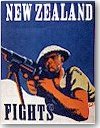
The I. Battalion (Hauptmann von der Heydte) dropped to the south
of the Alikianou-Canea road. They landed near their objective but immediatly
found themselves under heavy fire. The II. Battalion (Major Derpa) landed
north of the road, to the south-west of Galatas. Major Heilmann's III.
Battalion parachuted north-west of the village and descended into the middle
of heavy opposition. The 13. Kompanie (heavy mortars) was dropped over
a reservoir just north of Agia and the commander Oberleutnant Schimkat
and others were drowned. The survivors managed to recover a few of the
containers carrying the mortars.
The Fallshirm-Pionier-Battalion dropped just north of Alikianou
without too much difficulty. The combined efforts of the I. and II. Battalion
succeeded in securing Agia, and the prison there was used as Headquaters
for Oberst Heidrich and his regimental staff, who had dropped to the south-west
of the village. Generalleutnant Wilhelm Süssman was to meet up with
the staff of 7. Flieger-Division, who had landed in four gliders nearby,
but the towing line on his glider broke shortly after take-off and he and
the four man crew, crashing on the island of Aegina, were killed. During
the day Fallschirm-Jaeger-Regiment 3. was unable to progress in the direction
of Canea and the situation looked critical.
None of the prime objectives assigned to the first wave had been
secured by mid-day May 20. Hill 107 and Maleme airfield had not been taken
by Luftlande-Sturmregiment and Fallschirm-Jaeger-Regiment 3. was hemmed-in
around Agia in what was termed 'Prison Valley' with high casualties and
numerous commanders dead. Communications with headquarters on the Creek
mainland had been practically non-existent; headquarters under the impression
that the operation was going to plan. Problems with refueling the JU52's
and the dust on the Greek airfields was causing the second wave timetable
to become disrupted. This forced the second drop to fly in small groups
instead of en- masse.
The Second Wave:
Fallschirm-Jäger-Regiment
2 at Retimo
At 3:00 p.m. Oberst Sturm's Fallschirm-Jäger-Regiment 2. - minus
most of its II. Battalion, which had been assigned to the attack at Heraklion-landed
at Retimo in a sector held by elements of the 19th Australian Brigade.
Many were scattered and some troops were dropped in the wrong place, with
many injured after landing on rocky ground. The I. Battalion (Major Kroh)
landed just east of the airfield and captured the vineyard covered hill
which overlooked it. The III. Battalion (Hauptmann Wiedemann) found himself
in a similar situation at the eastern edge of the airfield and both groups
decided to dig in.
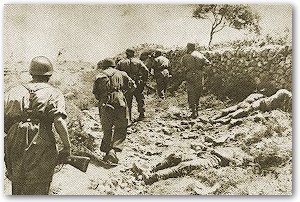
At Heraklion the Regiment the I. Battalion (Major Walther)
parachuted east of the town in the Vathianos Gournes area with the regimental
staff and it's commander (Oberst Braüer).
Two companies landed further west, but the determined defence and the
problem of dispersion meant the situation was far from satisfactory;
Baüer knew he could not take the airfield that day as planned.
General Sudent and the IX. Fliegerkorps staff had pieced-together a
clearer picture of the true situation from wireless signals received: Gruppe
West had managed to gain a foot hold at Maleme but had not taken the Hill
or the airfield; Gruppe Mitte was in a critical situation at Canea and
Retimo where elements of Fallschirm-Jäger-Regiment 2. were in a critical
situation; Gruppe Ost had failed to gain Heraklion or the airfield there.
A flotilla of twenty five boats with reinforcements to land at Heraklion
had been delayed and would not depart until the next day.
It was decided that the foot-hold perimeter near Maleme was the
one position that could be exploited. Student decided to concentrate on
Maleme and employ the 5. Gebirgs-Division there instead of the Heraklion
sector. The new plan was to roll up the British and Dominion positions
from the west. This was a very risky decision as a counter-attack by Freyberg
would cost the gamble. Fortunately no counter-attack was forthcoming.
MAY 21:
Arrival of the Mountain troops

After the mistake of ordering back companies A and B from Hill 107
by Lieutenant-Colonel L. W. Andrew (commander 22nd New Zealand Infantry
battalion), the weary paratroops were able to overcome the confused defence
and take control of the hill. This left the way open for German control
of Maleme airfield.
German air strikes began around 2:30 p.m. against New Zealand positions
east of the airfield, preceding the air-drop of the reserves 4. And 12.
Kompanie of Fallschirm-Jäger-Regiment 1, and a third company (under
the command of Oberleutnant Klein) made up of members of Fallschirm-Jäger-Regiment
2. III. Battalion finally overran the airfield defences, aided by the day's
new arrivals. With the airfield still under artillery fire, the first Ju52
carrying mountain troop reinforcements landed at Maleme about 4:00 p.m.
With shells exploding around the landing aircraft the situation soon
became chaotic; transports were piled everywhere after some collided or
were destroyed by artillery fire.
But the loses of men versus aircraft was deemed acceptable. 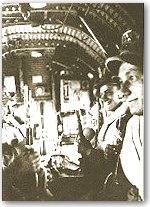
Oberst Utz (Commander Gebirgs-Jäger-Regiment 100) was in Maleme
with his staff by early evening. 650 mountain troops had reinforced the
Maleme sector and at 6:00 p.m. Oberst Ramcke had landed to take command
of Gruppe West to begin re-organisation.
The situation still remained serious for Gruppe Mitte near Retimo
and Gruppe Ost near Heraklion as they faced some 7,000 allied soldiers.
To the west of the airfield Hauptmann Wiedemann's III. Battalion had to
dig-in near Perivolia just east of the town. The Germans managed to hold
out for several days against determined counter-attacks by heavy artillery
and armour.
The Failure of the Seaborne Reinforcement
May 21-22
A flotilla of 63 requisitioned vessels was put together to carry part
of the 5. Gebirgs-Division to the island; since there were not enough aircraft
to carry out both initial and rapid build up. Most of these commandeered
vessels were caiques (fishing boats dependent on a sail and a small auxiliary
engine). There were to be two flotillas-one to carry 2,250 mountain troops
to Maleme-the other to carry 4,000 men to Heraklion. On the night of May
19th the first flotilla had arrived at the island of Milos and anchored
there. A change of plan occurred on May 20th and both convoys were ordered
to sail to Maleme. At a pace of only 7 knots, the first convoy was attacked
by the British naval task force lead by Admiral Rawlings at around 11:00pm.
For two and a half hours the British hunted the caiques down, sinking a
large number of them. The second flotilla had set sail southwards from
Milos on May 22nd when at about 9:30am when they within range of
another naval task force. But due to Luftwaffe activity overhead Admiral
King broke off the attack in fear of a mounting air-attack. This second
flotilla was recalled to spare it the same fate as the first and
no further seabourne landings were attempted until the island was in German
control.
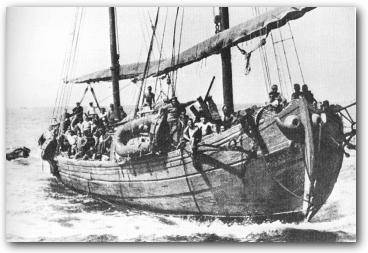
The III. Battalion of Gebirgs-Jäger-Regiment 100 had been
decimated by the naval action and virtually disappeared as a fighting force.
The 5. Gebirgs-Division reported 506 missing, including 18 officers in
the Crete campaign-most having drowned with the caiques. 178 survivors
were rescued by air sea planes and another 64 by launches. A few managed
to reach land, suffering from exposure but still carrying their weapons!
May 22nd saw renewed action by the Luftwaffe against the British naval
task forces and the British suffered heavily; two cruisers and a destroyer
were sunk as well two battleships and two cruisers damaged. After these
attacks by the Luftwaffe the British could no longer operate during the
day near Crete or in the Agean sea.
MAY 22
Reinforcements and supplies were continually arriving on Crete and by
12:00pm the whole of I. Battalion of Gebirgs-Jäger-Regiment 100 had
been bought in, followed by the II. Battalion, the I. Battalion of Gebirgs-Jäger-Regiment
85 and then Gebirgs-Pionier-Battalion 95under Major Schatte. Divisional
commander General Major Julius Ringel flew in and assumed command of all
forces in the Maleme area, and organised the forces there into three battle
groups: Kampgruppe Schaette was to protect the Maleme area from any western
threat and push westwards to capture Kastelli; the second group, made up
of paratroops under command of Oberst Ramcke, was to strike northwards
to the sea to protect the airfield and then extend eastwards along the
coast; and third under command of Oberst Utz, was to move eastwards into
the mainland, partly with a flanking movement across the mountains.
MAY 23
As the three battle groups moved forward, I. Battalion (Gebirgs-Jäger-Regiment
85) headed eastwards of Kampgruppe Utz and reached the village of Modi
in the afternoon-but encountered heavy defensive action by the New Zealanders.
The I. Battalion (Gebirgs-Jäger-Regiment 100) had outflanked the position
by marching across the mountains to the south and after a very determined
defence, the village soon fell.
Hill 259 was essential to the next phase of the operation and after
heavy hand-to-hand fighting upon the bare slope-the Germans succeeded.
During the night the New Zealanders pulled back to avoid being cut off
and moved the artillery back south east of Platanias; as a result Maleme
airfield was no longer under attack.
Gebirgs-Pionier-Battalion 95 had come under attack from armed
civilians (including women and children) on the west of the island. These
bands had carried out atrocities on the dead and wounded-some suffering
appalling torture before dying. East of Maleme the III. Battalion of Luftlande-Sturmregiment
had suffered badly form such incidents, especially during the first night
on the ground when Cretan partisans had mutilated all the dead and wounded
they could find-about 135 men in total. After this the Germans announced
that for every soldier killed in this fashion ten Cretans would be shot
in reprisal; the Luftwaffe dropping leaflets warning the population of
the measures that would be taken against partisan activity.
During the day supplies were bought forward, and men landed at
Maleme. About twenty aircraft were landing every hour-some carrying artillery,
anti-tank guns and various heavy equipment. II. Battalion of Gebirgs-Jäger-Regiment
100-of which the remainder had landed in the morning - were sent eastwards
to support Kampfgruppe Utz.
MAY 24-26
Generalmajor Ringel was able to regroup as more reinforcements landed
on the island. During the night of 24th-25th Gebirgs-Jäger-Regiment
100 gained contact with Oberst Heidrich's paratroops-surrounded in prison
valley since the 20th. Gebirgs-Pionier-Battalion 95 had entered Kastelli
to the west after air support from Stukas. On the 25th south west of Canaethe
German troops comprised of Oberst Ramcke's paratroops on the left flank
along the coastline; in the centre Kampfgruppe Utz with two Battalions
of Gebirgs-Jäger-Regiment 100; and on the right the paratroops of
Oberst Heidrich's regiment. Around Galatas in the afternoon fierce hand-to-hand
combat raged between the mountain troops and the New Zealanders of the
10th New Zealand Brigade. The Germans succeeded in forcing their way into
the village, but after a counter attack by two companies of the 23rd Battalion
and the 5th New Zealand Brigade they were forced to lose ground. The next
morning the mountain troops re-entered the village after the New Zealanders
had withdrawn during the night.
MAY 27
More troops were thrown against Canea by Generalmajor Ringel as he deployed
a battle group comprising of two battalions of Gebirgs-Jäger-Regiment
141 (which had arrived on the 25th and the other on the 26th) under command
of Oberst Jais on the right of Gebirgs-Jäger-Regiment 100. In front
of Canea the mountain troops overcame a determined defence by British
forces, and by afternoon the Gebirgs-Jäger-Regiment 100 had penetrated
the town. Gebirgs-Jäger-Regiment 141 held-fast against counter attacks
by New Zealand and Australian troops to the south west of Suda. This was
actually rear guard action aimed at holding the Germans back, while the
main body withdrew southwards towards Sphakia and the ships of the Royal
Navy. When the Germans finally entered Canae and Suda bay, they found it
deserted. Kampfgruppe Krakau had toiled trough the mountains further
south and had flanked opposition and occupied the heights above Stilos
on the 27th.
A blocking position of artillery and tanks pinned down the mountain
troops as they approached Stilos at about 6:30am. The Suda-Sphakia road
was vital for the push eastwards; defence of it-vital for the British.
With the arrival of anti-tank grenade riflemen and artillery and mortars
the situation was turned in the German's favor. Late on May 27th Gebirgs-Artillerie-Regiment
95 was ordered by Generalmajor Ringel to advance east to pursue the retreating
enemy and move as quickly as possible toward Retimo and Heraklion, to relieve
paratroopers cut off there.
MAY 28-30
Kampfgruppe Wittmann advanced at 3:50am-unchecked until just outside
Suda where the road was cut by craters; a British commando unit had landed
at Suda and had blocked the road. A flanking attack was mounted while mortars,
anti-tank and mountain guns opened against the defenders. At midday, resistance
was overcome and contact with elements of Kampfgruppe Krakau was gained-pursuit
continued without interference as far as Kaina. Here, resistance was met
with the main lay-force who staunchly held their ground. Kampfgruppe Wittman
lacked good observation points for it's artillery, so had to wait for Kampfgruppe
Krakau for support; the odds were turned in the German's favour by last
light.
The pursuit continued on the 29th, and Retimo was entered at 1:00pm-contact
with III. Battalion of Fallschirm-Jäger-Regiment 2 established.
The 29th was spent clearing up Retimo and several hundred prisoners were
taken.
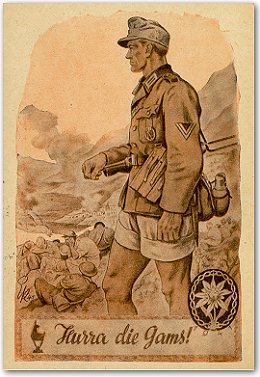
The evacuation order of May 27th had not reached Allied troops
in Retimo but Brigadier Chappel had received it at Heraklion and - except
for the wounded - 4,000 men were embarked during the night of 28th 29th
aboard ships under the command of Admiral Rawlings. When the paratroops
closed in on the British positions at Heraklion early on the 29th, the
airfield and town were taken without a shot being fired. At Retimo 700
prisoners were taken after surrendering to the bombardment of German artillery.
After a detachment was left to guard the prisoners, Kampfgruppe
Wittman resumed the march east at 7:30am. An hour later contact was made
with the eastern group of Fallshirm-Jäger-Regiment 2. At 11:45 am
contact was gained with a reconnaissance patrol from Fallschirm-Jäger-Regiment
1 which had been holding out in the Heraklion area since the afternoon
of the first day. The advance continued with a couple of tanks (which had
been landed by sea)-leading the way for safety.
MAY 29-JUNE 1
The German command had failed to realise that the British evacuation
was occurring south in the fishing village at Sphakia. Large forces had
not been sent south towards the port and this was not rectified until May
31. At 8:50am on the May 29th I. Battalion of Gebirgs-Jäger-Regiment
100 of Kampfgruppe Utz was sent southwards and that afternnon the II. Battalion
also moved-advancing until 6:00pm, when determined rearguard action was
encountered just north of Kares. The attack was resumed by the mountain
troops in the morning and further progress was made to reach a point about
two and a half miles from the coast. By the evening of May 30th the whole
of Crete, except the Loutro-Sphakia area, was in German hands.
 |
| Enter Soldiers
Letters |
General Freyberg left the island that evening in a flying boat-sent
to Sphakia to take him off the island. The Royal Navy evacuated almost
15,000 men to Egypt, and as a result of the naval activity several ships
were damaged and sunk. The Germans were unable to push down to the coast
until 9:00am June 1st-when British rearguard forces surrendered; the war
diary of the 5. Gebirgs-Division recorded that final resistance was overcome
at 4:00pm in the mountains north of Sphakia.
The cost to the Germans of Operation Merkur was high. Of the 22,000
men committed for the operation approximately 6,000 were casualties. Key
figures killed during the battle: Generalleutnant Süssmann, Major
Braun, Major Scherber, and Oberleutnant van Plessen. The mountain troops
lost 20 officers and 305 other ranks, killed in action; the missing-most
of them drowned when the Royal Navy sunk the boats transporting them, numbered
18 officers and 488 other ranks. Of the nearly 500 transport aircraft involved,
271 had been lost.
The British and Dominion casualties were 1.742 killed, 1,737 wounded
and 11,835 taken prisoner.
For the Royal Navy the battle cost the Mediterranean fleet: three
cruisers and six destroyers sunk; one aircraft carrier and three battleships,
and six cruisers and nine destroyers-damaged. Over 2,000 men killed and
almost 500 wounded.
 After Crete the German parachute
arm was never used again in large scale airborne operations.
After Crete the German parachute
arm was never used again in large scale airborne operations.
Bibliograpy
The German Invasion Of Crete - Jean Paul
Pallud
The Fall Of Crete - Allan Clark
Alpine Elite & Hitlers MountainTroops
- James Lucus.
Special thanks to Patrick Kiser for the original
Period Postkarkte
|
